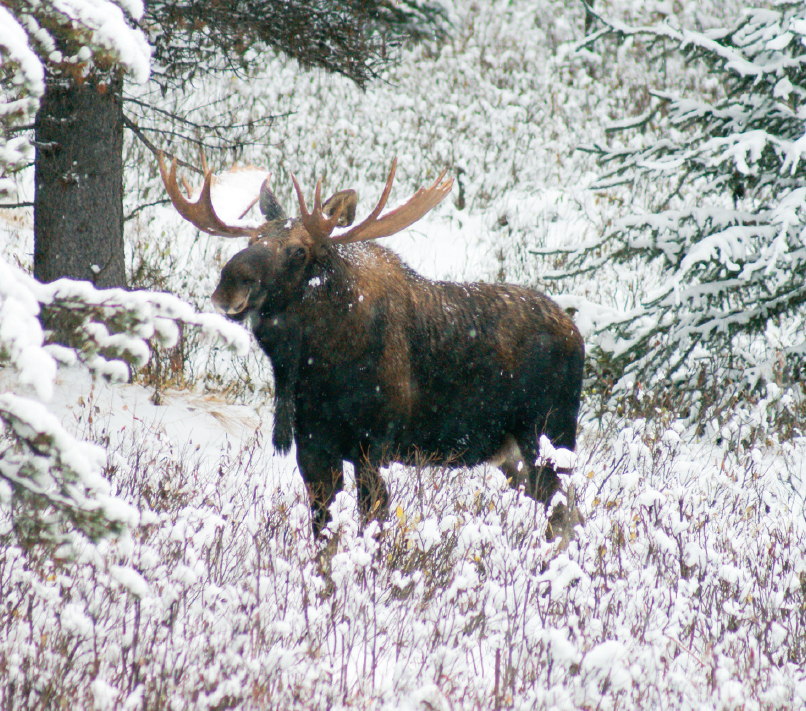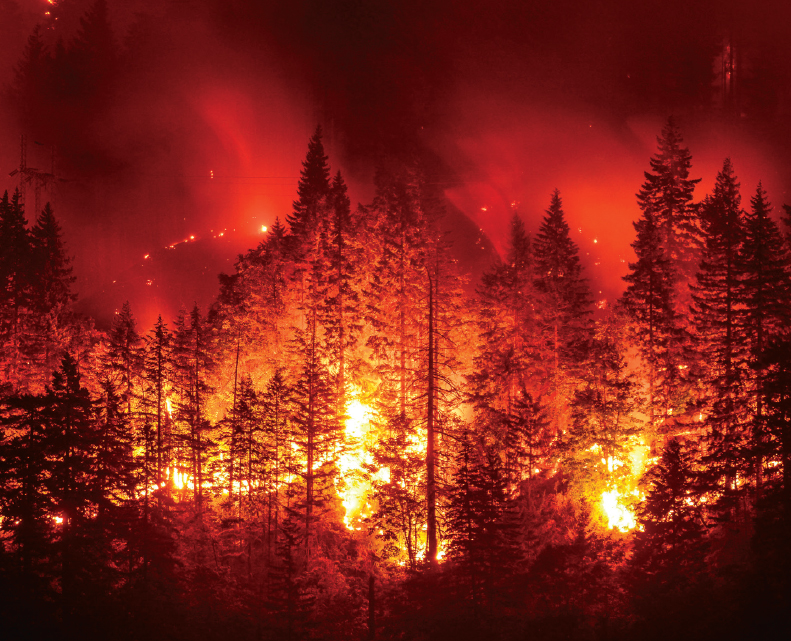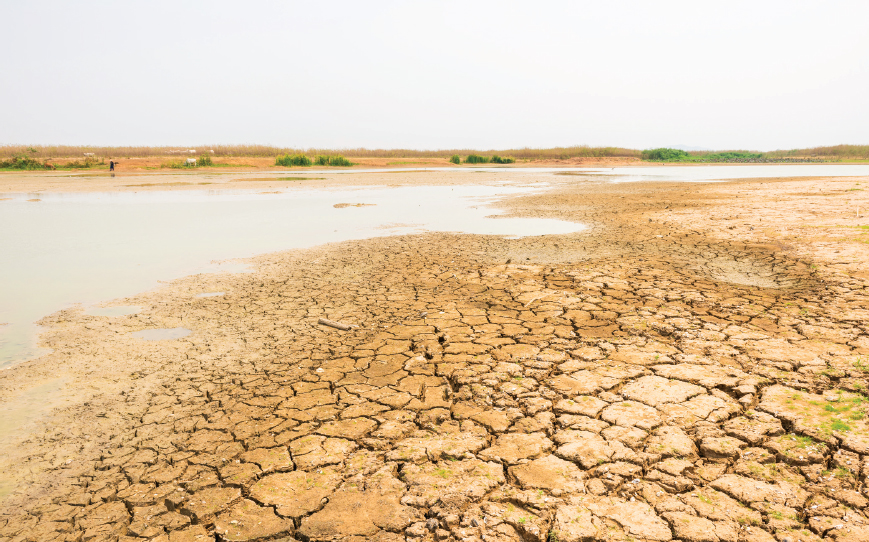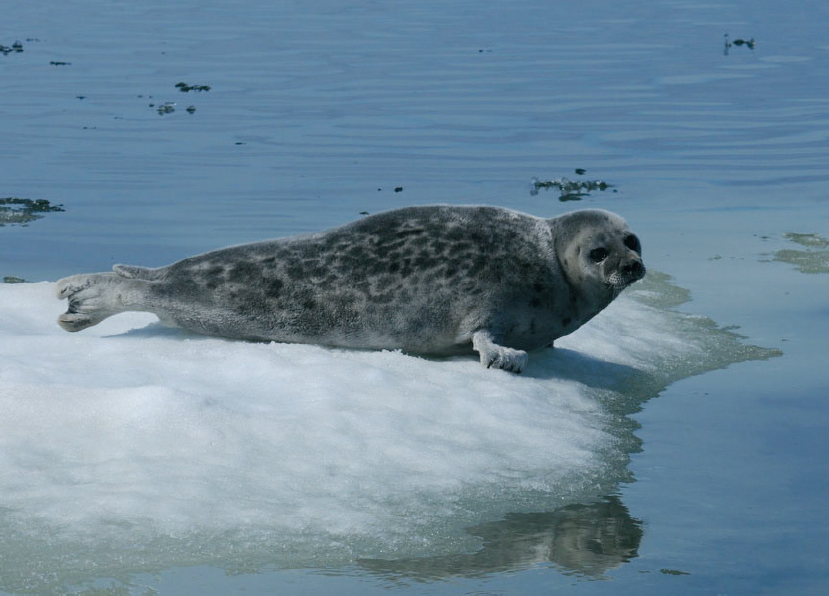1 Ecosystems Are Rapidly Changing
Ecosystems around the globe are rapidly changing in response to climate change and other human-induced stressors. Average global temperature has increased by about 1 °C (1.8 °F) since the industrial revolution, with much of this increase taking place since the mid-1970s,3,4 and further increases expected if emissions of heat-trapping greenhouse gases continue. In October 2018, the Intergovernmental Panel on Climate Change warned that allowing the planet to warm more than 1.5 °C (2.7 °F) could have long-lasting and in some cases irreversible consequences for ecosystems and that this threshold will be passed by 2030 if current rates of warming continue.5 In addition to rising temperatures, researchers are observing changes in precipitation patterns, the occurrence and severity of extreme events, species’ behaviors, and the chemistry of the ocean, among other effects. Concurrently, ecosystems are being modified by a multitude of human-induced stressors, including resource extraction, habitat degradation and conversion, invasive species, and pollution.
Climate change and other pressures affect the health and function of ecosystems as well as the wide variety of species that live in them.6 Changes are being observed on land, in freshwater systems, and in the ocean. The climate could be pushed into a different state
___________________
3 NAS (National Academy of Sciences). 2014. Climate Change: Evidence & Causes. Washington, DC: The National Academies Press.
4 IPCC. 2018. Summary for Policymakers. In: Global Warming of 1.5°C. An IPCC Special Report on the impacts of global warming of 1.5°C above pre-industrial levels and related global greenhouse gas emission pathways, in the context of strengthening the global response to the threat of climate change, sustainable development, and efforts to eradicate poverty. V. Masson-Delmotte, P. Zhai, H.-O. Pörtner, D. Roberts, J. Skea, P. R. Shukla, A. Pirani, Moufouma-Okia, C. Péan, R. Pidcock, S. Connors, J. B. R. Matthews, Y. Chen, X. Zhou, M. I. Gomis, E. Lonnoy, Maycock, M. Tignor, and T. Waterfield, eds. Geneva, Switzerland: World Meteorological Organization.
5 Ibid.
6 IPBES (Intergovernmental Science-Policy Platform on Biodiversity and Ecosystem Services). 2019. Summary for policymakers of the global assessment report on biodiversity and ecosystem services of the Intergovernmental Science-Policy Platform on Biodiversity and Ecosystem Services. Bonn, Germany: IPBES Secretariat. https://www.ipbes.net/news/ipbes-global-assessment-summary-policy makers-pdf, accessed August 2, 2019.
by numerous competing processes once a threshold has been surpassed. In addition, gradual climate changes can cross thresholds or tipping points in both natural systems and human systems, leading to abrupt change7 (see Box 1). The extinction threat for marine and terrestrial species is an example of a tipping point under way today. According to the World Wildlife Fund for Nature’s Living Planet Report, released shortly before the forum, populations of vertebrate animals—including mammals, birds, and fish—declined by an average of 60% between 1970 and 2014 due to overexploitation, agriculture, and other forms of land conversion. Climate change is a growing threat to these populations.8 These declines occurred in all bioregions, with the largest impacts occurring in the tropics. Other recent reports have also suggested large-scale declines of invertebrates.9
“Within a few decades, either we will be committed to a substantially warmer climate or we will have taken major actions to avoid such a climate. Ecosystems will play a major part in dealing with both scenarios.”
—YADVINDER MALHI, University of Oxford

___________________
7 NRC. 2013. Abrupt Impacts of Climate Change: Anticipating Surprises. Washington, DC: The National Academies Press. DOI: https://doi.org/10.17226/18373.
8 WWF (World Wildlife Fund). 2018. Living Planet Report 2018: Aiming Higher. Gland, Switzerland: WWF.
9 Hallmann, C. A., M. Sorg, E. Jongejans, H. Siepel, N. Hofland, H. Schwan, W. Stenmans, A. Müller, H. Sumser, T. Hörren, D. Goulson, and H. de Kroon. 2017. More than 75 percent decline over 27 years in total flying insect biomass in protected areas. PLOS ONE 12(10):e0185809. DOI: 10.1371/journal.pone.0185809.
CHANGES TO TERRESTRIAL ECOSYSTEMS
Terrestrial ecosystems include areas of natural or semi-natural vegetation cover as well as areas that are more intensely managed, such as forest plantations, agricultural croplands, and urban and suburban areas. All of these ecosystems are vulnerable to impacts of climate change and other stressors, but they may vary in how they are affected due to the complex interactions among species, disturbances, and other factors. Human pressures such as landscape fragmentation can result in animal and plant species existing in more patchy environments than in the past, often in small populations. Such landscape fragmentation reduces species’ capacity to migrate in response to climate change and other stressors.
Many terrestrial ecosystems are well adapted to long standing patterns of natural disturbances such as fires, storms, or periods of drought. However, increases in the frequency and intensity of these disturbances, as well as interactions with other factors such as climate variability, mean that events may recur before the system has a chance to recover from a previous disturbance. Furthermore, the effects of multiple events become synergistic and cause more stress than in the past. This can lead to abrupt loss of some of the ecological memory or adaptive capacity of the ecosystem, resulting in a rapid transition to a new ecosystem type or a mixture of species that differs from the pre-disturbance state. For example, in Yellowstone National Park,

“We are seeing increases in observations of abrupt change in many ecosystems … these are big changes that are fast in time … they often surprise us … and this is a major challenge in contemporary ecology, but especially as we think about the effects of climate change.”
—MONICA TURNER, University of Wisconsin–Madison
fires are occurring more frequently and burning more severely such that fewer seeds remain to establish a new forest; seeds can be unable to reach all burned areas if a fire is large.10 The present conditions under which the forest will regenerate also differ from their previous state because of climate change.
Complex relationships between climate change and species ranges have also been identified in the absence of major disturbances. For instance, many species have shifted northward and upslope as temperatures have increased. Recent research also shows that some species are shifting downslope and to the west or east in response to precipitation changes associated with climate change.11 This new understanding suggests climate change has had a larger impact on species ranges than previously estimated and that future warming is likely to cause even greater effects.
Managed terrestrial ecosystems are also influenced by climate change and other stressors in complex ways. A globally predominant managed ecosystem type is agricultural land; about 11% of Earth’s ice-free land surface was recently estimated to be cropland and about 22% pasture.12 In general, agriculture is becoming more efficient, which should mean that less land is needed to produce the same yield. However, adoption of more efficient agriculture is not happening quickly enough to outpace the combined effects on demand of increases in human population and per-capita food consumption, so further conversion of natural ecosystems to agricultural land is occurring. Concurrently, climate change is threatening yields (see Figure 1), which could cause cropland expansion—primarily by converting natural ecosystems to agricultural production—with negative consequences for ecosystem services, such as reduced water quality, air quality, and biodiversity.13 Nutrient loading or scarcity is an additional compounding factor in global agricultural patterns.
The linkage between climate change and agriculture is further complicated by the role that agriculture itself plays in driving further climate change. As a sector, agriculture (including soil and nutrient management and emissions from livestock), combined with
___________________
10 Turner, M. G., K. H. Braziunas, W. D. Hansen, and B. J. Harvey. 2019. Short-interval severe fire erodes the resilience of subalpine lodgepole pine forests. Proceedings of the National Academy of Sciences of the United States of America. DOI: 10.1073/pnas.1902841116.
11 Fei, S., J. M. Desprez, K. M. Potter, I. Jo, J. A. Knott, and C. M. Oswalt. 2017. Divergence of species responses to climate change. Science Advances 3(5):e1603055. DOI: 10.1126/sciadv.1603055.
12 Ramankutty, N., A. T. Evan, C. Monfreda, and J. A. Foley. 2008. Farming the planet: 1. Geographic distribution of global agricultural lands in the year 2000. Global Biogeochemical Cycles 22(1). DOI: 10.1029/2007gb002952.
13 Molotoks, A., E. Stehfest, J. Doelman, F. Albanito, N. Fitton, T. P. Dawson, and P. Smith. 2018. Global projections of future cropland expansion to 2050 and direct impacts on biodiversity and carbon storage. Global Change Biology 24(12):5895-5908.
forestry and other land uses (e.g., wetland conversions and other managed lands), accounts for 24% of global greenhouse gas emissions,14 meaning that these practices directly contribute to climate change, while also being impacted by it. At the same time, agricultural ecosystems can take up carbon dioxide from the atmosphere, which helps to mitigate climate change, and there is potential to increase this uptake (see Chapter 3).

SOURCE: Cline, W. 2007. Global Warming and Agriculture: Impact Estimates by Country. Washington, DC: Peterson Institute.
___________________
14 Smith, P., M. Bustamante, H. Ahammad, H. Clark, H. Dong, E. A. Elsiddig, H. Haberl, R. Harper, J. House, M. Jafari, O. Masera, C. Mbow, N. H. Ravindranath, C. W. Rice, C. Robledo Abad, A. Romanovskaya, F. Sperling, and F. Tubiello. 2014. Agriculture, Forestry and Other Land Use (AFOLU). In: Climate Change 2014: Mitigation of Climate Change. Contribution of Working Group III to the Fifth Assessment Report of the Intergovernmental Panel on Climate Change. O. Edenhofer, R. Pichs-Madruga, Y. Sokona, E. Farahani, S. Kadner, K. Seyboth, A. Adler, I. Baum, S. Brunner, P. Eickemeier, B. Kriemann, J. Savolainen, S. Schlömer, C. von Stechow, T. Zwickel and J. C. Minx, eds. Cambridge, United Kingdom, and New York, NY: Cambridge University Press.
CHANGES TO FRESHWATER AND MARINE ECOSYSTEMS
Water covers about 70% of Earth’s surface and houses a range of saltwater (marine) and freshwater ecosystems. Only about 2.5% of this water is fresh, and most of that is in the form of ice, leaving a relatively small amount available for freshwater ecosystems. However, this small fraction of liquid freshwater harbors about 10% of the planet’s known animal species15 and supports critical ecosystem services, such as the production of a sustained clean drinking water supply. Both freshwater and marine systems are sources of food, transport, waste disposal, energy production, and protection for shorelines and coastal communities.
Freshwater Ecosystems
Abrupt and irreversible changes in the makeup and function of freshwater ecosystems are increasingly likely with climate change.16 Many freshwater species have shifted their ranges,

___________________
15 Dudgeon, D. 2014. Threats to Freshwater Biodiversity in a Changing World. In: Global Environmental Change. Handbook of Global Environmental Pollution, vol 1. B. Freedman, ed. Dordrecht, the Netherlands: Springer.
16 IPCC. 2014. Summary for Policymakers. In: Climate Change 2014: Impacts, Adaptation, and Vulnerability. Part A: Global and Sectoral Aspects. Contribution of Working Group II to the Fifth Assessment Report of the Intergovernmental Panel on Climate Change. C. B. Field, V. R. Barros, D. J. Dokken, K. J. Mach, M. D. Mastrandrea, T. E. Bilir, M. Chatterjee, K. L. Ebi, Y. O. Estrada, R. C. Genova, B. Girma, E. S. Kissel, A. N. Levy, S. MacCracken, P. R. Mastrandrea, and L. L. White, eds. Cambridge, United Kingdom, and New York, NY: Cambridge University Press.
behaviors, and interactions with other species. At the same time, climate change effects on temperature and precipitation can result in droughts that reduce connectivity across systems and heavy rain events that produce damaging floods. Freshwater systems also face many other threats, including pollution, dams, fishing, watershed modification, and invasive species. Even seemingly isolated riverine ecosystems, such as portions of Amazonia, are being affected by mining, deforestation, and the construction of dams.17 Meanwhile, 4 billion people already face severe water scarcity, which may be further exacerbated by climate change.18
“A lot is happening in the ocean, even in places that used to be so far away from us that we couldn’t imagine having any impacts at all.”
—NANCY KNOWLTON, Smithsonian Institution
Marine Ecosystems
Marine ecosystems also face many threats from climate change. The number of heatwave days has increased dramatically in recent decades as the ocean has warmed, which has severely stressed organisms.19 The ocean’s oxygen content has also declined in many areas, creating inhospitable conditions for many species. In the open ocean, this oxygen decline is due to warming, whereas along coastlines it is caused by nutrient pollution from land sources that leads to eutrophication.20 Increasing absorption of atmospheric carbon dioxide into the ocean is also causing acidification, which affects the ability of organisms to produce shells and hard skeletons. Along low-lying coastal areas, rising sea levels are causing extensive flooding that affects local ecosystems as well as communities living in these areas.
Among marine ecosystems, coral reefs have been and will continue to be particularly affected by warming temperatures and the growing risk of ocean acidification.21 Coral bleaching events (in which corals expel the photosynthetic algae that live inside their tissues and become white in appearance) have become increasingly common, largely because of temperature extremes. Even if coral reefs do not die from a single bleaching,
___________________
17 Castello, L., and M. N. Macedo. 2016. Large-scale degradation of Amazonian freshwater ecosystems. Global Change Biology 22(3):990-1007.
18 Mekonnen, M. M., and A. Y. Hoekstra. 2016. Four billion people facing severe water scarcity. Science Advances 2(2):e1500323.
19 Oliver, E. C. J., M. G. Donat, M. T. Burrows, P. J. Moore, D. A. Smale, L. V. Alexander, J. A. Benthuysen, M. Feng, A. S. Gupta, A. J. Hobday, N. J. Holbrook, S. E. Perkins- Kirkpatrick, H. A. Scannell, S. C. Straub, and T. Wernberg. 2018. Longer and more frequent marine heatwaves over the past century. Nature Communications 9:1324.
20 Breitburg, D., L. A. Levin, A. Oschlies, M. Grégoire, F. P. Chavez, D. J. Conley, V. Garçon, D. Gilbert, D. Gutiérrez, K. Isensee, G. S. Jacinto, K. E. Limburg, I. Montes, S. W. A. Naqvi, G. C. Pitcher, N. N. Rabalais, M. R. Roman, K. A. Rose, B. A. Seibel, M. Telszewski, M. Yasuhara, and J. Zhang. 2018. Declining oxygen in the global ocean and coastal waters. Science 359(6371):eaam7240. DOI: 10.1126/science.aam7240.
21 NASEM (National Academies of Sciences, Engineering, and Medicine). 2018. A Research Review of Interventions to Increase the Persistence and Resilience of Coral Reefs. Washington, DC: The National Academies Press. DOI: https://doi.org/10.17226/25279.
degraded reefs are more susceptible to subsequent disturbances compared to reefs that have not previously bleached.22
Marine ecosystems are also facing a large number of other threats. Since 1970, populations of more than 1,000 marine species have undergone declines of approximately 50%,23 and considerable habitat losses have been observed in key ecosystems including mangroves, seagrasses, and coral reefs. Fisheries are unmanaged or poorly managed across much of the world, and declines in these systems continue in most regions. Marine ecosystems are also much more intensively used today than in the past for purposes beyond fishing, including energy generation, transport, mining, and waste disposal. Even the deepest regions of the ocean are now becoming at risk from human activities.24

__________________
22 Hughes, T. P., K. D. Anderson, S. R. Connolly, S. F. Heron, J. T. Kerry, J. M. Lough, A. H. Baird, J. K. Baum, M. L. Berumen, T. C. Bridge, D. C. Claar, C. M. Eakin, J. P. Gilmour, N. A. J. Graham, H. Harrison, J.-P. A. Hobbs, A. S. Hoey, M. Hoogenboom, R. J. Lowe, M. T. McCulloch, J. M. Pandolfi, M. Pratchett, V. Schoepf, G. Torda, and S. K. Wilson. 2018. Spatial and temporal patterns of mass bleaching of corals in the Anthropocene. Science 359(6371):80-83. DOI: 10.1126/science.aan8048.
23 WWF. 2015. Living Blue Planet Report: Species, Habitats and Human Well-Being. Gland, Switzerland: WWF.
24 Danovaro, R., J. Aguzzi, E. Fanelli, D. Billett, K. Gjerde, A. Jamieson, E. Ramirez-Llodra, C. R. Smith, P. V. Snelgrove, L. Thomsen, and C. L. Dover. 2017. An ecosystem-based deep-ocean strategy. Science 355(6324):452-454.









